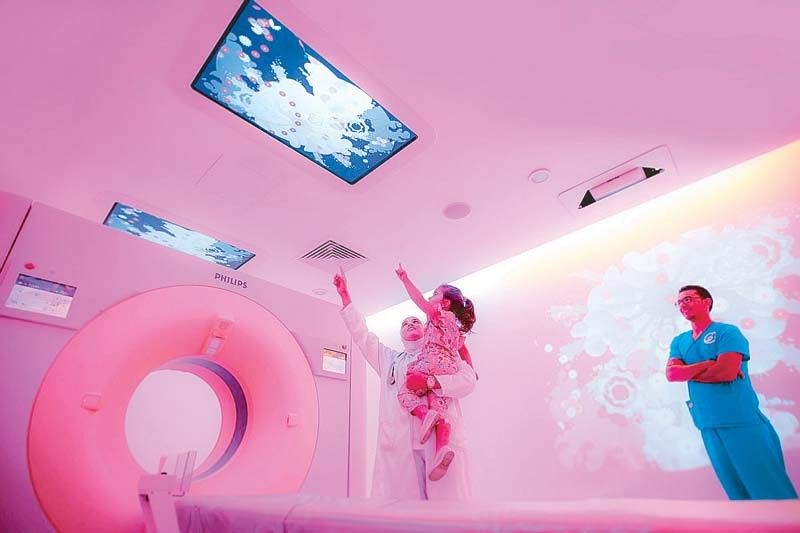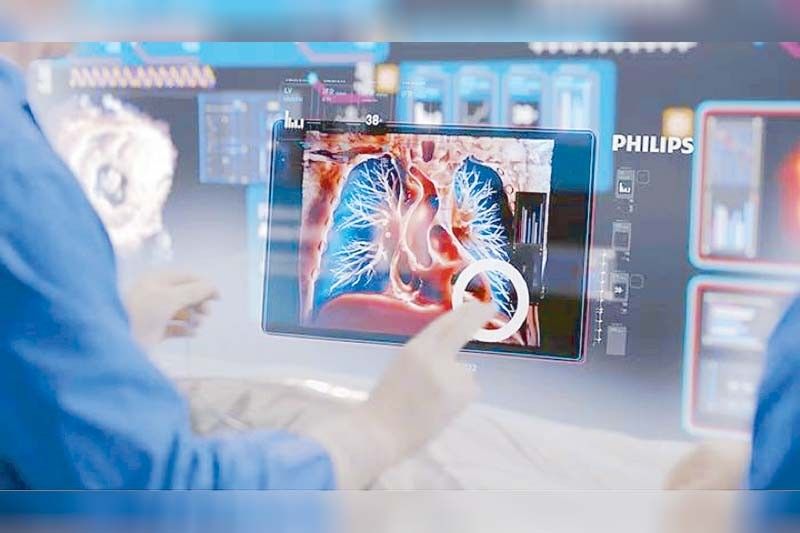A futuristic look at healthcare
A futuristic look at healthcare unknown
No challenge has shed more light on the critical need to modernize healthcare systems than the COVID-19 pandemic. Everyone — from healthcare providers to hospitals and top health technology companies — had to learn to pivot and continuously rethink and rework the way they do things to help build a stronger and digitally powered healthcare ecosystem centered on the patient.
This new ecosystem embraces a new approach to caregiving — one that revolutionizes healthcare beyond the walls of the traditional hospital.
Beyond hospital walls
Imagine a world with infinite access to healthcare; where anyone can receive care at the snap of their fingers. And how all these will be enabled by one simple but fundamental shift in technology.
For example, receiving seamless health screenings — like managing your diabetes — in the comfort of your car seat. Your biometric eye scan seamlessly monitors your blood sugar level. And your insulin dosage is then adjusted accordingly and administered by the armrest. You will also receive a reminder to tap your insulin prescription as you’re running low. Wouldn’t it be nice to enjoy prevention during your daily commute?
Think of this. In 2030, healthcare is decentralized. Hospitals will only consist of crucial elements that require patients to be on site. All other functions will be redistributed and made entirely mobile in a network of hyper-connected autonomous vehicles. So, instead of going to the hospital, how about the hospital going to you?
“For decades, healthcare has been primarily delivered in centralized facilities like hospitals,” said Caroline Clarke, CEO and executive vice president of Philips Asia and the Pacific (APAC), as she presented the findings of Philips 2023 Future of Health Index (FHI) Report to members of the press at the Philips APAC Center in Singapore. “But this latest report shows that APAC’s healthcare leaders are making bold changes as they navigate unprecedented staff and financial challenges.”
Clarke was joined by Dr. Marc Burby, vice president, Health and Systems Solutions for Philips APAC; and Keith Brighton, head of Services and Solutions Delivery for Philips Growth Region.
Titled “Taking Healthcare Everywhere,” the report, which surveyed nearly 3,000 respondents spanning healthcare leaders and young healthcare professionals in 14 countries, including Australia, Indonesia and Singapore, shows that a new model of healthcare is emerging in APAC.
“The good news is, it puts the patients first,” added Clarke. “We are seeing a shift towards a distributed model of care delivery in APAC that uses smart and connected digital health technologies and data to bring care closer to patients — at home, in the community, and to where they are — anytime, anywhere.”
The new model uses technology and data to bring care closer to patients and deliver care in a more efficient and environmentally sustainable way, even as the sector grapples with unprecedented financial pressures and staff shortages.

The new immersive MRI from Philips prioritizes patient comfort for all ages.
At a crossroads: The APAC healthcare system
Still on its way to recovery, the APAC healthcare system is at a crossroads. And while there are pockets of opportunity emerging, there are also challenges that have been present for a long time.
For example, by 2050, one in four people in the Asia-Pacific region will be over 60 years old. This means that demand for healthcare services can only increase. The Asia-Pacific also faces a growing problem of chronic or non-communicable diseases partly due to the aging population. Another roadblock is the global shortage of skilled healthcare professionals, which has resulted in greater need for operational efficiency, and better work flow processes.
Amid the challenges, there are also opportunities to explore. Telehealth was widely adopted during the pandemic. It only means that resistance to change can be overcome when there’s a clear and present need to do so.
Patients also realized that healthcare can be delivered outside hospital walls. This realization has come with the demand for increased access to care beyond the traditional hospital.

Diagnostic tools have become more convenient in a new age of technology
An innovation company with a heart
“Philips is an innovation company,” shared Clarke during her presentation. “We’ve been here for 130 years. And you’ll see us in a variety of places within the hospital.”
Philips is one of the top three players in diagnostic imaging, and supports diagnosis and minimally invasive treatments. The company is No. 1 in cardiac ultrasound, image-guided therapy, imaging, and monitoring and supporting workflow solutions.
“Philips’ purpose is to improve people’s health and well-being through meaningful innovations. And we aim to improve the lives of 2.5 billion people by 2030,” shared Clarke as she cited some of the trends that are impacting the healthcare industry post-pandemic.
According to Clarke, staff shortages are really key at the moment. “And 10 million is the expected global deficit by 2030.”
The future of healthcare: A smart and connected ecosystem
To address this problem, APAC healthcare leaders are at the forefront of using technology. Based on the report, two-thirds (67 percent) of them (versus 56 percent globally) already use, or plan to use, digital health technology to reduce the impact of healthcare workforce shortages.
And the top three technologies to relieve the impact of staff shortages are cloud-based technology to support access to information from any location, technology solutions that connect with out-of-hospital settings, and workflow technology (e.g., PACS, digital health records, patient flow automation).
The report also cited that embracing digital transformation and new care delivery models could also help with attracting talent.
Younger healthcare professionals identified being at the forefront of artificial intelligence (39 percent) and new care-delivery models that connect different care settings (33 percent) as top priorities when choosing where to work.
Besides highlighting the importance of doubling down on digital technologies to tackle staff shortages, the FHI report also reveals that embracing new care models will help the region’s healthcare leaders to drive more efficient and sustainable ways of working.
According to Mark Burby, vice president, Health and Systems Solutions for Philips APAC, the future of healthcare is, indeed, moving towards taking healthcare everywhere.
“And this means extending patient care beyond hospital walls. This also means a more efficient and accessible way of working for better patient outcomes,” added Burby, who gave us a glimpse of how a smart digital healthcare ecosystem of the future looks like.
Based on the report, healthcare professionals in Asia and the Pacific view digital technology to be really key to the success of new care-delivery models of adaption.
“Forty-two percent of healthcare professionals believe that a key technology that has made the biggest impact already is telehealth. No doubt. You may have had some experiences in that over the COVID period,” Burby said.
AI is also expected to grow and have the biggest impact in the next three years, especially in diagnostics.
“Other healthcare and technology trends that are relevant in this shift towards moving to accessing healthcare outside hospitals include the Internet of Things — or the Internet of Medical Things, which is a network of medical devices that enables real-time monitoring, improves patient engagement, and facilitates preventive care,” explained Burby.
Blockchain, which enhances data security, interoperability and patient privacy, is also used to revolutionize systems such as medical records management, and supply chain logistics, among other areas.
Another example is virtual reality (VR) and augmented reality (AR), which can be applied in training, patient education, and surgical procedures.
“Overall, innovation and cutting-edge technology is really going to shape the smart digital future of healthcare,” Burby added. “And connecting people data and technology in intelligent ways through a distributed healthcare mode is the future.”
Healthcare leaders and young healthcare professionals in APAC have a very clear vision of the future of care delivery.
“It will be connected. It will bring healthcare closer to patients,” noted Clarke.
Healthcare leaders are starting to recognize the importance of sustainability and they are actively looking for ways to reduce their carbon footprint in the long-term provision of healthcare.
On developing smart hospitals and achieving ‘the quadruple aim’
Philips has been working with its partners in APAC on new business models and engaging in long-term strategic partnerships to innovate care delivery.
This includes supporting APAC health systems in developing smart hospitals that seamlessly bring people, data and technology together to achieve the industry’s Quadruple Aim as follows:
• Improving the patient’s experience of care
• Improving the health of individuals and populations
• Improving the work life of health professionals
• Reducing the per capita cost of healthcare.
Being aware that services, upgrades, sustainable innovations and practices, as well as training and education, are key to the long-term success of digital transformation, Philips offers integrated and comprehensive suites of systems, smart devices, software and services to address the specific pain points faced by healthcare providers and ultimately unleash the full possibilities of digital transformation.
* * *
To access the Future Health Index 2023 report in its entirety, visit GH Future Health.